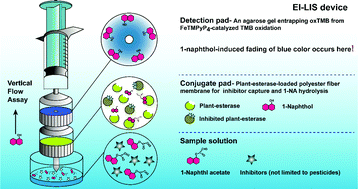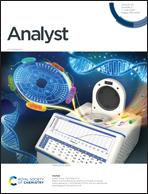An enzyme inhibition-based lab-in-a-syringe device for point-of-need determination of pesticides†
Abstract
An enzyme inhibition-based lab-in-a-syringe (EI-LIS) device was developed by integrating a 1-naphthol-linked bi-enzymatic reaction (sensor core) into the LIS (sensor device) for point-of-need monitoring of pesticide residues. The integration relies on the rational design of two reaction pads. The conjugate pad is a polyester fiber membrane loaded with plant-esterase, an alternative to acetylcholinesterase. Besides pesticide capture, plant-esterase also mediates the hydrolysis of 1-naphthyl acetate, generating 1-naphthol. The detection pad is an agarose gel entrapping oxidized 3,3′,5,5′-tetramethylbenzidine (oxTMB) from Fe(III) meso-tetra(N-methyl-4-pyridyl) porphyrin (FeTMPyP4)-catalyzed TMB oxidation. Both pads were embedded into their cartridges and then connected to a syringe. Under syringe pumping, 1-naphthol vertically flowed from the conjugate to the detection cartridge, linking the two pads. If plant-esterase was intact, 1-naphthol would reduce oxTMB, causing a color change of the detection pad from blue to colorless. If the plant-esterase activity was inhibited by pesticides, less 1-naphthol was produced, and the blue color of the detection pad would be partially or wholly retained. The deeper the blue color, the greater the pesticide concentration. This chromogenic pattern is responsible for a highly sensitive readout (detection limits of dichlorvos: 0.1 nM with the naked eye and 0.07 nM with a spectrometer).



 Please wait while we load your content...
Please wait while we load your content...